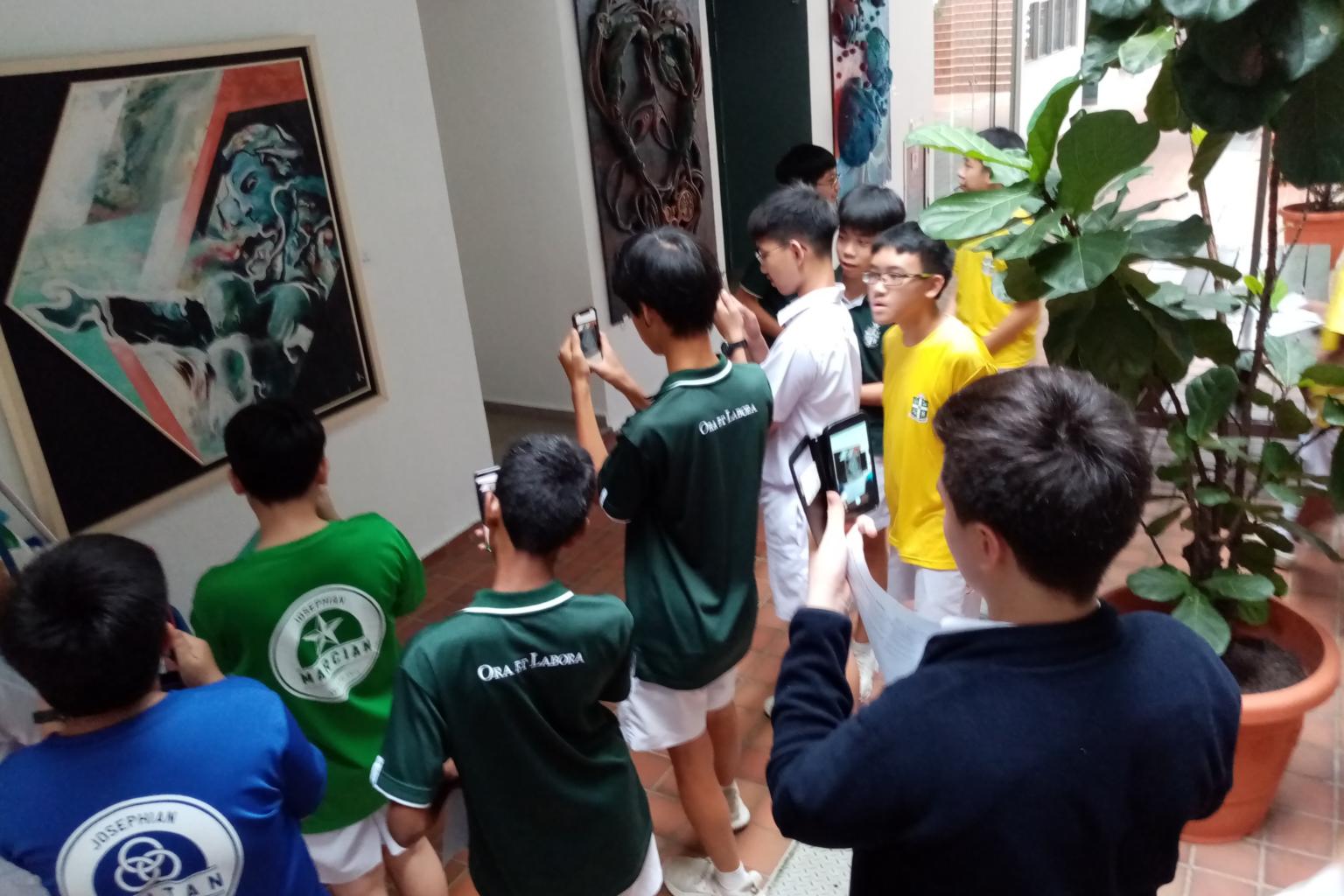Teaching and learning by design: How to engage students and spark creativity
Sign up now: Get ST's newsletters delivered to your inbox

St. Joseph’s Institution students testing an augmented reality prototype on a piece of artwork.
PHOTO: ST. JOSEPH'S INSTITUTION
Jolene Ang
Follow topic:
SINGAPORE - When Dr Muhammad Nazir Amir first started teaching at Greenview Secondary School in 2002, he realised his students were easily distracted.
It got him thinking about ways to better engage them and he spent the next 15 years conducting classroom research and developing a new pedagogy to make learning more relevant, appealing and personal.
Dr Nazir's experience was part of a series of stories shared at the Design Education Summit on Thursday (Feb 4).
The summit, which is in its second edition, was organised by the DesignSingapore Council - Singapore's national agency that promotes design - and the SUTD-MIT International Design Centre.
In 2005, while Dr Nazir was accompanying students on a volunteer trip to a Movement for the Intellectually Disabled of Singapore (Minds) school, he passed by a pre-school class and noticed that the Minds teachers were also struggling to engage the young children.
"This became a design opportunity to conceptualise a storytelling project for the children. We had an idea to design and make science-based toys that could make fairy tales and nursery rhymes come alive," said the 43-year-old, who is now a master teacher in educational support at the Education Ministry's Academy of Singapore Teachers.
This is one example of having a design mindset - an approach to creative problem-solving that applies across sectors, including education. The focus is on building empathy in re-framing and resolving problems.
Through the project, Dr Nazir's students at Greenview Secondary were able to pick up science, art, English and computer application concepts.
For instance, in the story of Rapunzel, the students came up with a way to depict the scene of the prince climbing the tower, using a kitchen towel roll integrated with a wheel-and-axle attached to a pulley.
The students' English teacher came in to train them in narration and dramatisation skills, while graphic and animation skills in PowerPoint were also taught during computer applications lessons.

Said Dr Nazir: "Through this project, the students found a sense of purpose to learn. Different teachers were also able to buy in... In the end, students come to the lessons because they want to and not because they have to.
"It instilled in them a sense of self-worth and heightened self-esteem. They were not just contributing with their service and time, but also with their knowledge in various domains. As a teacher, I saw that they became interested and engaged."
Another story featured at the summit on Thursday was one at St Joseph's Institution, where students were involved in a design education initiative of their own.
In January last year, a group of Secondary 2 students in the school's arts programme came up with the idea of using augmented reality (AR) to transform the viewing experience of various pieces of artwork from alumni that are displayed around the school.
This was done outside of curriculum time.

Ms Jessica Cheng, 27, one of the teachers in charge of the arts programme, said: "Our key objective with this initiative was to think about how we can use technology to tell stories as well as view art. The students were able to create solutions to create a better user (viewer) experience, which is relevant and in line with the nature of design thinking."
The students created a discovery trail, where visitors can use their mobile phone cameras to find clues around one art piece that lead to the next.
Said Ms Cheng: "To them, learning is usually within the classroom and graded with a set of assessment rubrics. But with this, they saw learning in a new light, that it need not be bounded by that."
One of the speakers at Thursday's summit, Mr Pann Lim, noted that design goes beyond products and aesthetics.
Mr Lim, 48, is co-founder and creative director at advertising agency Kinetic Singapore and art collective Holycrap.sg.
He said: "I see design differently, in the way we think. My background is in advertising and design, so I showcase projects that are design-skewed, but with examples of how we derived the concept - a sneak peek into how we think. That's more important than how we design."
Young people will have to understand that "the usual way of working is not the same anymore", he added.
With the gig economy on the rise, many may choose to take up multiple jobs concurrently.
"If I had said to my parents years ago, I'm taking up three to four jobs in a week or month, they would have said, 'No, go for a stable job.'
"But everything is so different now. People make money from YouTube, churning content online, using their following and influence on Instagram to find ways of making money.
"There used to be a few ways of reaching your destination, but these days, there are many routes... Creativity is not necessarily about doing design or being artistic: it's a way of thinking."

